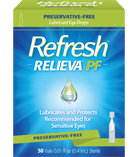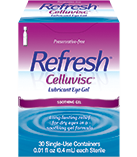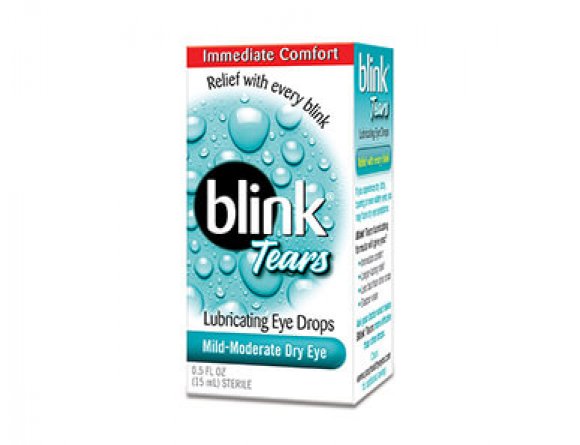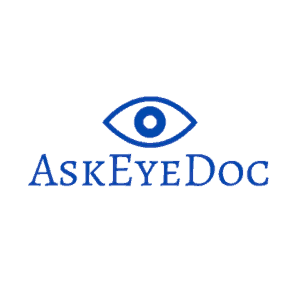Written By: Dr. Stephanie Mulick, O.D.
Your eye doctor may recommend artificial tears to help relieve symptoms of dry eye.
Dry eye symptoms:
- Burning
- Foreign body sensation
- Redness
- Irritation
- Gritty or sandy sensation
- Tearing
If you experience any of these symptoms you will definitely want to read my article on dry eye triggers and treatments (click here to read).
Symptoms of itching are more likely related to an allergy than dry eyes; however cold artificial tears can be very effective at relieving itchy eyes without the use of antihistamine which can exacerbate dry eye symptoms. I usually recommend trying cold artificial tears and cold compresses for itchy eyes before trying antihistamine eye drops due to the side effect of dry eyes.
How to choose which Artificial tear to use:
Choosing artificial tears can be overwhelming with so many options. It is always best to stick with preservative-free eye drops, due to the preservatives causing corneal toxicity with extended use as well as allergic reactions in some patients.

Most bottled eye drops contain preservatives to prevent bacterial growth. Some people have or develop sensitivity to preservatives, especially if used often. If you find that your artificial tear causes irritation or itchy eyes, try to switch to a preservative-free artificial tear.
Most preservative-free eye drops come in individual vials that can be recapped and then used for a couple of hours that day, but always open a fresh vial each day, since there is no preservative keeping out bacteria. There are some new preservative-free bottled eye drops in which the bottle has a unique mechanism to prevent bacterial growth inside. These preservative-free bottles can be used daily until the bottle is empty. The chart below specifies preservative-free vials or bottles).
If you are going to use artificial tears more than 4 times per day, it is best to stick with preservative-free eye drops.
Artificial tear Viscosity (thickness):
You also need to decide how thick you need the eye drop to be. The thicker the gel or ointment the longer it will provide relief, but the more likely you will experience blurred vision. It is best to use ointments right before bed. Some patients with severe dry eyes do like to use gel drops throughout the day and usually experience blurred vision for just a few minutes after using the gel.
I organized the chart by viscosities. Some brands do not make gel drops, ointments or contact lens drops.
The chart below shows the Optometrist recommended OTC eye drops based on the thickness. Starting with the thinnest (least viscous) drops that should not blur vision to contact lens drops, gel drops (may blur vision temporarily, but provide longer relief) and night-time ointments (providing long-lasting relief, with blurred vision).
| Manufacturer | Day-time artificial tears | Contact lens drops | Gel drops | Night-time ointments |
| Allergan |  Refresh Relieva (Preservative Free bottle) |  Refresh for contacts |  Refresh Celluvisc (preservative-free vials) |  Refresh PM or Lacri-Lube |
| Alcon |  Systane complete Or Systane Ultra (preservative-free vials) |  Systane for Contacts |  Systane gel drops |  Systane Nighttime Or GenTeal Tears Gel |
| Johnson & Johnson |  Blink Tears |  Blink for Contacts | Blink Gel Drops | |
| Akorn |  Thera tears (preservative-free vials) |  Thera tears Nightime (preservative-free vials) | ||
| Bausch & Lomb |  Soothe XP (preservative-free vials) |  Soothe Nighttime | ||
| OcuSoft |  Retain MGD (preservative-free vials) | |||
| Eyevance pharmaceuticals |  Freshkote (preservative-free bottle) |
Red Eyes:
Red eyes are definitely frowned upon in the beauty industry. So, it is no wonder so many people turn to redness-relief drops. Red eyes can be a sign of much more than just lack of sleep. If you have chronic red eyes make sure to see your eye doctor for evaluation.
The causes for dry eyes are numerous and unless evaluated under a slit-lamp microscope by an eye doctor, the diagnosis would be difficult.
21 typical triggers for red eyes are:
- Smoke exposure
- Environmental irritants
- Inflammation
- Dry Eyes
- Conjunctivitis
- Allergies
- Cold or Flu
- Contact lens overwear
- Glaucoma
- Eye drops that treat glaucoma
- Eyelash growth serums (ie: Latisse)
- False eyelashes
- Blepharitis
- Eyelid laxity (aging skin)
- Eye injury or surgery
- Eye rubbing
- Stress
- Lack of sleep
- Excessive screen time on electronic devices
- UV exposure
- Radiation
The list can go on and on, which is why it is so important to see your eye doctor on a regular basis at least once per year or as directed by your eye doctor.
Avoid whitening or redness-relief eye drops:
Most redness-relief eye drops contain decongestants that cause vasoconstriction (constriction of the blood vessels) leading to a lack of oxygen. This lack of oxygen triggers a signal to the brain leading to neovascularization (growth of new blood vessels). Neovascularization causes our eyes to become redder with time, which is the opposite effect of what we want with redness-relief.
The medication in redness relief drops also cause rebound vasodilation (increased diameter of blood vessels) leading to an increase in redness of the eyes usually to a degree stronger than initially present. This cycle of vasoconstriction, neovascularization, and vasodilation leads to dependence and overuse of redness relief drops with a decrease in effect over time.
Neovascularization is also very common in contact lens wearers due to lack of oxygen transmitting through the contact lens. It is very important to change your contact lenses as directed and to clean them properly to get the most oxygen transmissibility.
Some popular redness-relief eye drops to avoid include Opcon-A, Naphcon-A, clear eyes, and Visine.
In July 2018 Bausch & Lomb introduced Lumify derived from a glaucoma eye drop called brimonidine. Studies have shown that Lumify allows for more optimal blood flow from larger feeder vessels of the eyes, while still creating effective vasoconstriction of the superficial vessels that cause redness in the eyes. Make sure to talk to your doctor if you are using Lumify and only use it as directed. Discontinue use if you develop an allergic reaction.
How to use Artificial tears:
Artificial tears are used to lubricate and moisturize our eyes. Usually, it is recommended to use artificial tears 3-6 times per day depending on your symptoms. Refer to the dry eye post for more treatment options.
If you need artificial tears more than 4 times per day then make sure to use preservative-free drops. When using preservative-free Artificial tears it is important to always open a fresh vial each day.
Always wash your hands before touching your eyes and make sure that the tip of the bottle does not touch your eye. It is ok to insert the drop anywhere into your eye as long as it gets in.
Always check the expiration date on the bottle or box and make sure the tip of the bottle looks clean.
Side Effects of Artificial tear usage:
There are very few side effects with the use of artificial tears. Allergy to artificial tears usually is due to preservatives in the eye drops. The symptoms of an allergy can be redness, burning, and itching. Switching to a preservative-free eye drop may relieve the allergy symptom. For itchy eyes due to allergy anti-histamine eye drops (such as Zaditor or Alaway) can be effective; however, the anti-histamine can cause more dryness.
Another potential side effect is temporary blurred vision, usually due to the thickness of the drops. Some artificial tears have a milky appearance that causes a temporary fog after installation for a few minutes.
If you wear contact lenses make sure to use eye drops specifically for contact lenses.
Conclusion:
With so many over-the-counter eye drops, it can be very overwhelming to choose the best eye drop for your specific need. Choose preservative-free whenever possible, avoid redness relief eye drops, and have your eyes examined yearly by your eye doctor to keep your eyes healthy.



Excellent post. I am going through many of these issues as well..